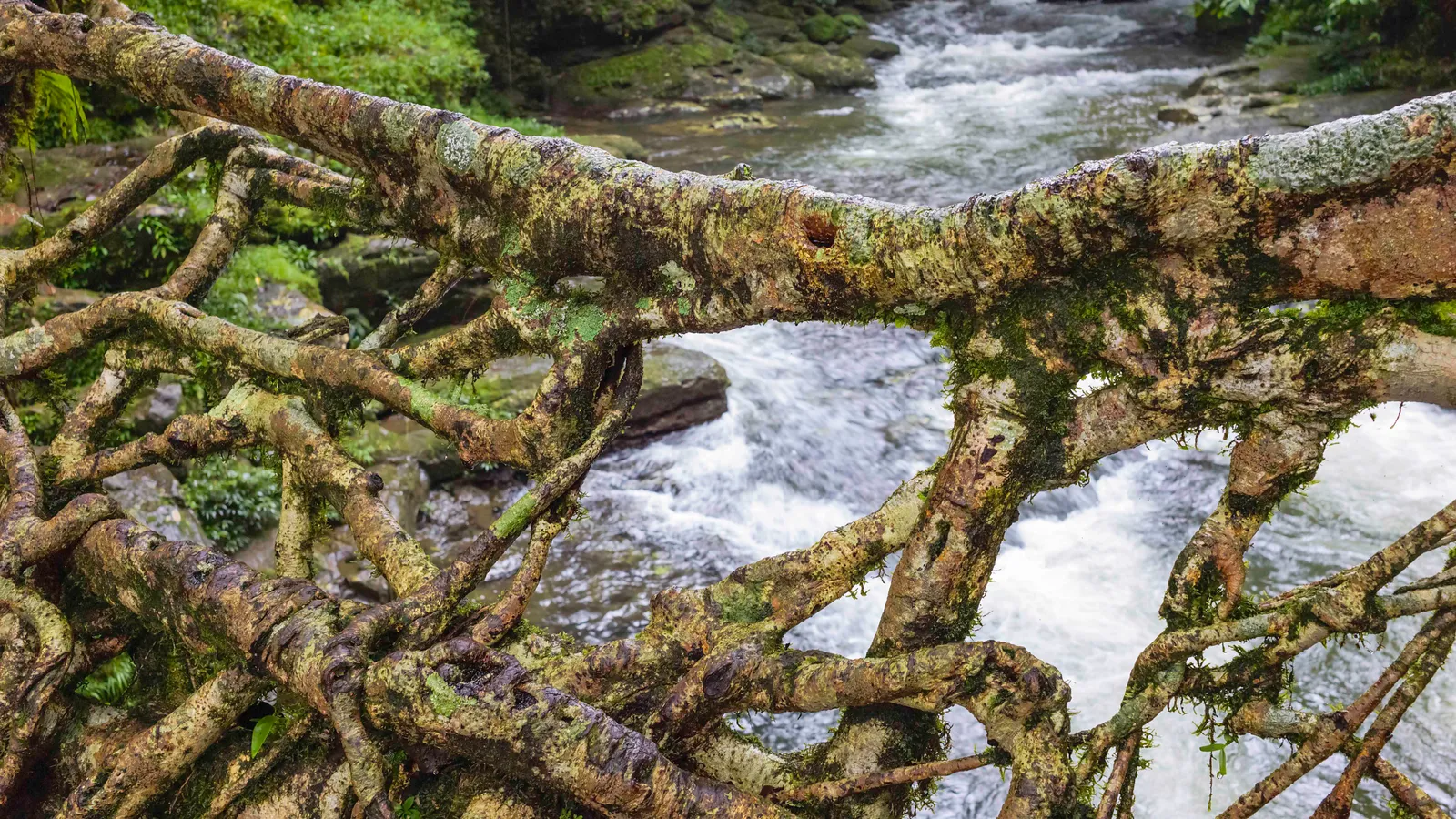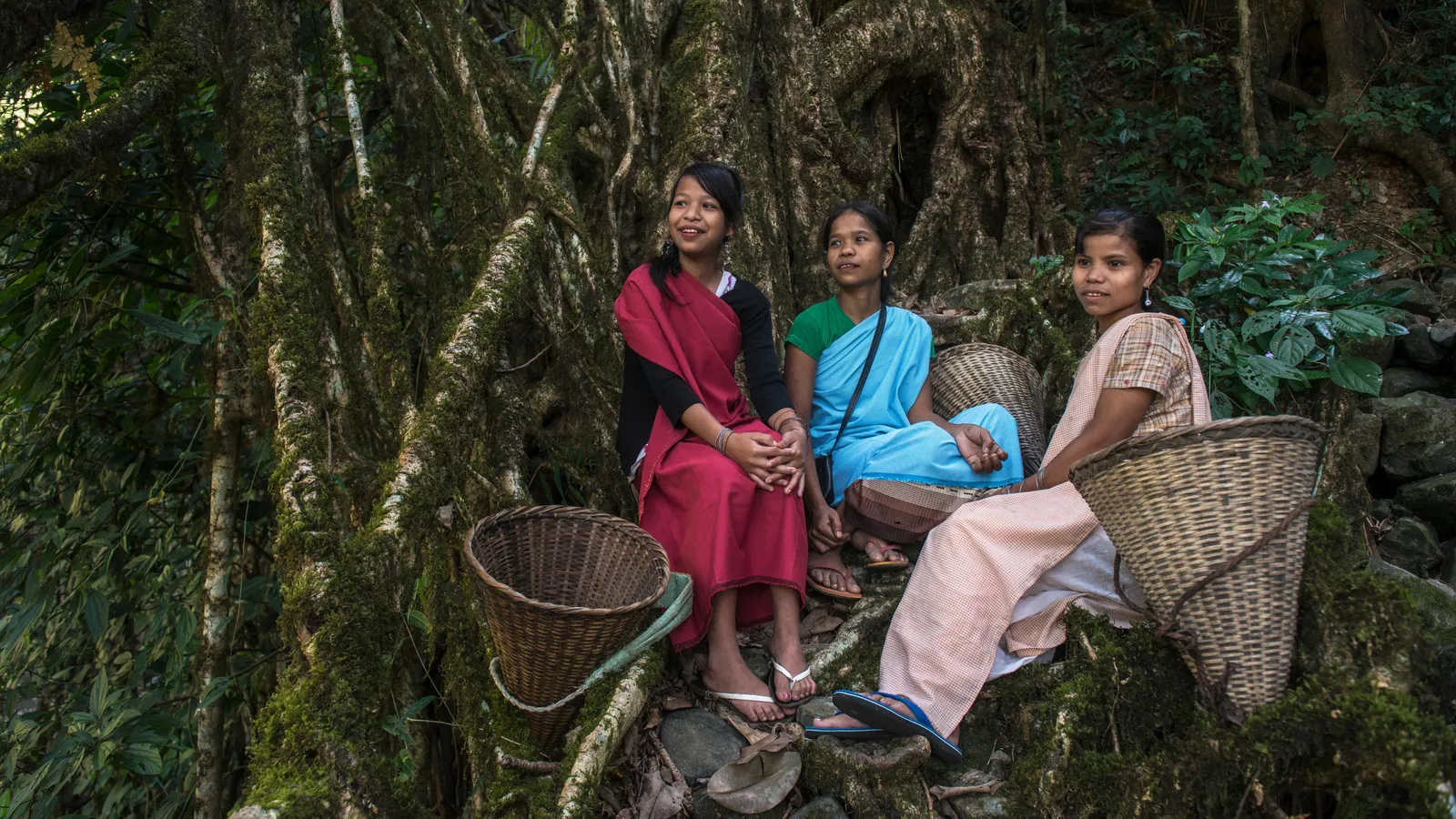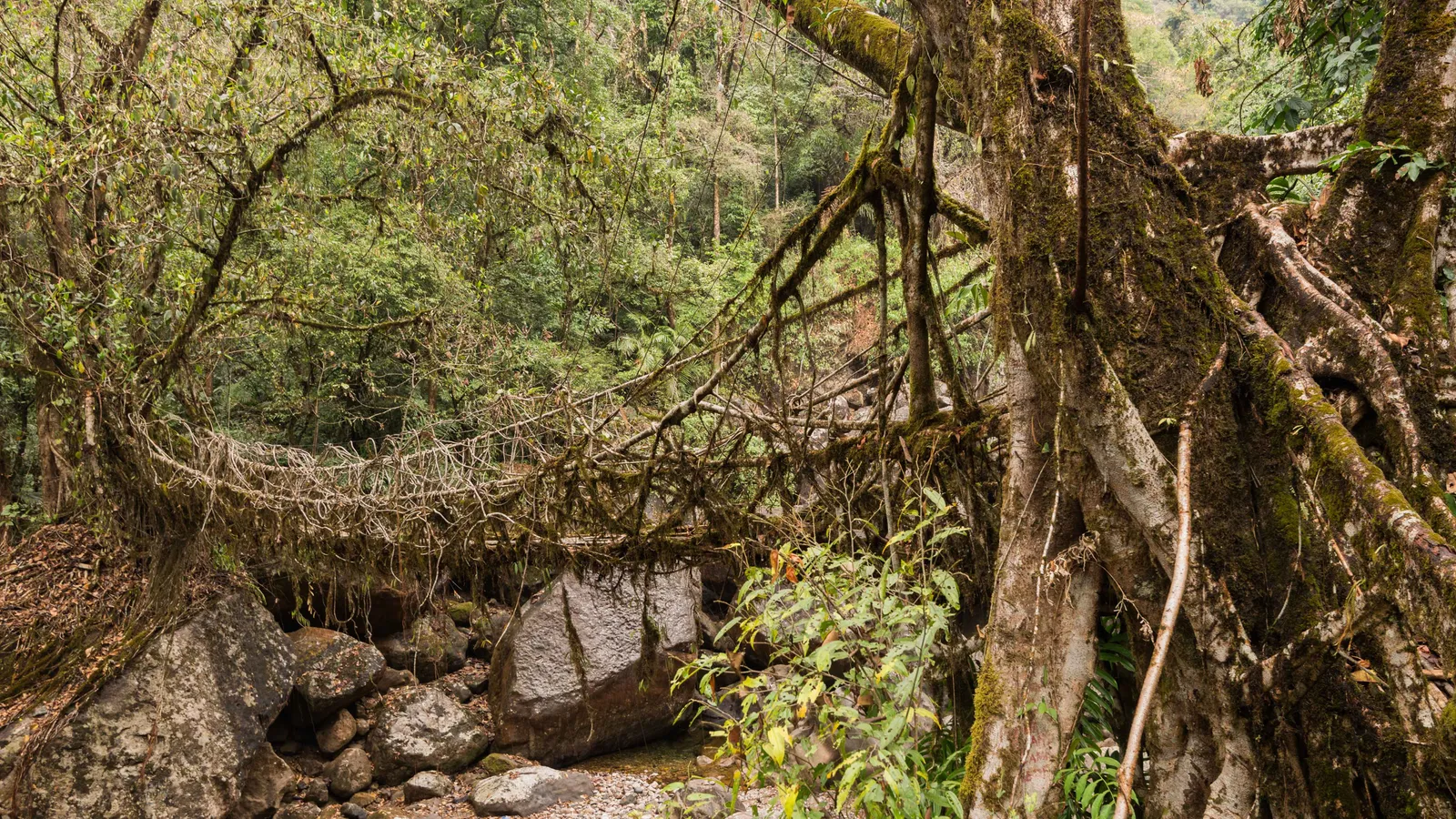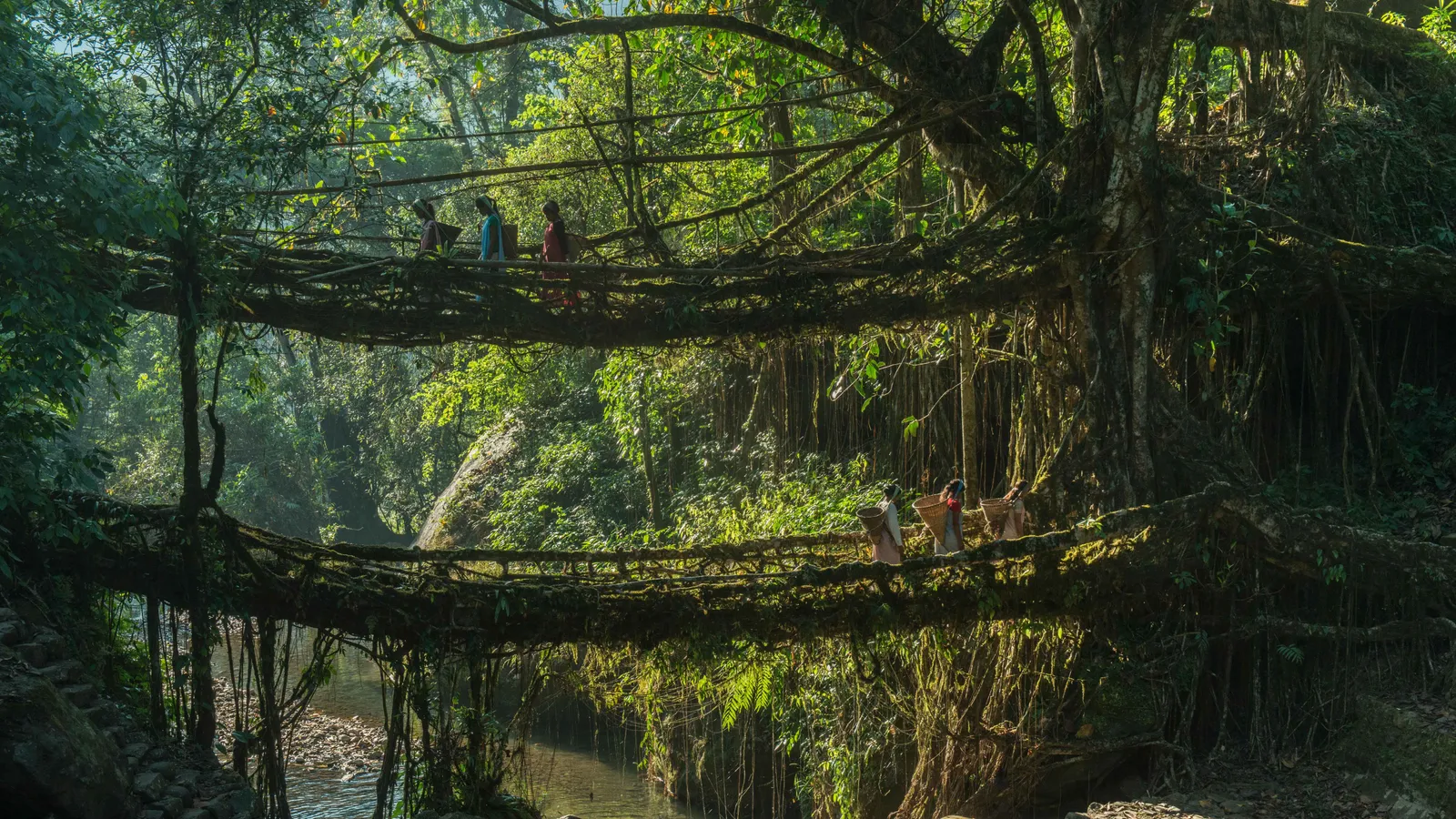Your vision will become clear only when you look into your heart.... Who looks outside, dreams. Who looks inside, awakens. Carl Jung
Monday, December 6, 2021
The ingenious living bridges of India
The ingenious living bridges of India
By Zinara Rathnayake
17th November 2021
For centuries, indigenous groups in north-east India have crafted intricate bridges from living fig trees. Now this ancient skill is making its way to European cities.
When monsoon clouds bring pelting rains to the village of Tyrna, Shailinda Syiemlieh takes the nearest bridge to reach the opposite bank of a gushing stream. The bridge is no ordinary structure made of concrete and metal. Instead, it is composed of a single giant fig tree that sits by the riverbank, and the support that Syiemlieh walks over is a mishmash of aerial roots tightly knotted and woven together. The bridge is not only a part of the landscape, it is helping to support its ecosystem at the same time.
Tyrna lies just above the plains of Bangladesh in the north-eastern Indian state of Meghalaya, which hosts hundreds of these bridges. For centuries, they have helped the indigenous Khasi and Jaintia communities to cross swelling rivers in monsoons. "Our ancestors were so clever," says Syiemlieh, "When they couldn't cross rivers, they made Jingkieng Jri – the living root bridges."
Meghalaya hosts some of the wettest locations on Earth. The village Mawsynram, the world's rainiest place, receives an annual rainfall of 11,871mm (39ft) – that would be enough to submerge a typical three-storey house if deluged all at once. Nearby Sohra comes second, averaging 11,430mm (37.5ft). From June to September, monsoon winds sweep north from the Bay of Bengal, passing over the humid plains of Bangladesh. When these air currents meet the hilly terrain of Meghalaya, they break open – and torrential rains begin.
When monsoon downpours periodically isolated the remote villages of Syiemlieh's ancestors from nearby towns, they trained living aerial roots of Indian rubber fig tree (Ficus elastica) to form a bridge across flooding rivers.
Researchers consider these living root bridges as an example of indigenous climate resilience. Aside from the connectivity they provide, these bridges attract tourists and help local people earn an income. Meanwhile, as researchers have found, they have regenerative effects on the surrounding environment. Scientists hope this concept of indigenous living architecture can help modern cities adapt better to climate change.
The trees are important not just for crossing rivers, but they hold a revered place in Khasi culture (Credit: Alamy)
Building these bridges takes decades of work. It begins with planting a sapling of Ficus elastica – a tree that grows abundantly in the subtropical terrain of Meghalaya – in a good crossing place along the riverbank. First the trees develop large buttressing roots and then, after about a decade, the maturing trees sprout secondary aerial roots from further up. These aerial roots have a degree of elasticity, and tend to join and grow together to form stable structures.
Carbon Count
The emissions from travel it took to report this story were 0kg CO2. The digital emissions from this story are an estimated 1.2g to 3.6g CO2 per page view. Find out more about how we calculated this figure here.
In a method perfected over centuries, the Khasi bridge builders weave aerial roots onto a bamboo or another wooden scaffolding, wheedle them across the river and finally implant them on the opposite bank. Over time, the roots shorten, thicken and produce offshoots called daughter roots, which are also trained over the river. The builders intertwine these roots with one another or with branches and trunks of the same or another fig tree. They merge by a process called anastomosis – where branching systems like leaf vessels, tendrils and aerial roots naturally fuse together – and weave into a dense frame-like structure. Sometimes, the Khasi builders use stones to cover the gaps in root structures. This network of roots matures over time to bear loads; some bridges can hold up to 50 people at once.
The generations that follow the initial bridge builders continue the maintenance of the bridge. While only one single person may maintain small bridges, most require the collective effort of families or the entire village – sometimes several villages. This process of care and development down the generations can last for centuries, with some bridges dating from 600 years ago.
As well as being a regenerative form of architecture, living root bridges grow stronger with time, self-repairing and becoming more robust as they age. "When it rains heavily, small cement bridges wash away and steel bridges tend to rust, but living root bridges withstand the rains," says Syiemlieh.
When it rains heavily, small cement bridges wash away and steel bridges tend to rust, but living root bridges withstand the rains – Shailinda Syiemlieh
"People came to realise that root bridges are much more durable than modern alternatives, and they cost absolutely nothing. So villagers now repair root bridges they had abandoned in the forest valleys."
This resurgence in interest in root bridges is in part thanks to the efforts of Morningstar Khongthaw, a native from Rangthylliang village, who founded the Living Bridge Foundation. Khongthaw and his team create awareness about root bridges, repair and maintain old bridges while also constructing new ones.
The living root bridges of north-east India have become famous as a tourist attraction - but they could also inspire European urban architecture (Credit: Getty Images)
Unlike conventional bridges, root bridges are also central to their surroundings. Apart from producing their own building material, the trees absorb the greenhouse gas carbon dioxide over their lifetimes. They help stabilise the soil and prevent landslides. Conventional bridges can disrupt the soil layers, but roots can anchor different soil structures which helps protect against soil erosion, says Ferdinand Ludwig, professor for green technologies in landscape architecture at the Technical University of Munich, who has been studying the bridges for 13 years.
This is true of many trees, but Ficus elastica plays a particularly important role in its ecosystem, says Salvador Lyngdoh, a local to Meghalaya and a scientist at the Biodiversity Institute of India, whose work focuses on conservation in the Himalayas. Fig trees are framework species that promote biodiversity around them: moss grows on them, squirrels live in their branches, birds nest within their canopy, and they support insects that help with pollination. The act of turning these trees into bridges can also help animals to thrive in their habitat, says Lyngdoh. Bark deer and clouded leopards are known to use root bridges to move from one part of the forest to another.
Root bridges may not be able to outperform the conventional kind in every sense, Lyngdoh notes. A conventional bridge can bear more weight, for example. "But root bridges are much more useful to a large sphere of natural species than the modern bridges we have," he says. "The living root bridge is a mosaic that's embedded within the forest. Species do not differentiate between the bridge and natural forest."
This form of indigenous architecture has fascinated scientists like the Technical University of Munich's Ludwig, for the potential to learn from them to make buildings and spaces in other parts of the world greener.
Ludwig sees these bridges as an example of not just sustainable development, which minimises the damage and degradation of natural systems, but of regenerative development. The latter attempts to reverse degradation and improve the health of the ecosystem. But understanding the living root bridges is not an easy process.
"There's no one way to build these bridges," says Ludwig. "How these roots are pulled, tied and woven together differ from builder to builder. None of the bridges looks similar."
The lack of historical written information on the bridges has also been a challenge in researching them. Until the British colonial period in the 19th Century, native Khasi inhabitants in Meghalaya didn't have a written script, as the Khasi way of life is passed down through oral histories. This has meant that documented information on the bridges is sparse.
The fig tree is uniquely adaptable to making root bridges, but other species can also be used to integrate into architecture, such as the London plane tree (Credit: Alamy)
So Ludwig's team turned to conversations with Khasi bridge builders and digital tools to understand the bridge-building techniques. They started with mapping the complicated shapes of roots and built digital skeletons of the bridges; next, they used photogrammetry – recording, surveying and interpreting root bridges using photographs – to document the bridges and construct 3D models using them.
With this information, Ludwig's team began designing a roof for a summer kitchen using a pavilion of trees, inspired by the root bridges.
"[Conventionally], when we construct a bridge or a building, we have a plan – we know what it's going to look like," says Ludwig. "But this isn't possible with living architecture. Khasi people know this; they are extremely clever in how they constantly analyse and interact with tree growth, and accordingly adapt to the conditions." Whenever a new root pops up, Khasi builders find a new way to integrate it into the structure.
But in Europe, with its very different climate, using Ficus elastica wasn't a viable option, so they had to make compromises, choosing instead Platanus hispanica, the London plane tree. "That's not all. The Khasi have incredible knowledge because they live in nature, and are deeply coupled with the ecosystems. We are not," says Ludwig. So his team used digital tools to mimic this process and to settle on a geometry that allowed for weaving twigs together into a roof. The team constantly trims and prunes the trees to encourage them to grow to keep the trees thinner.
"We are learning how to react to plant growth in Europe: humans plant trees, trees grow, humans react, trees react again," Ludwig says. "This way of interacting with nature is essential for a sustainable and regenerative future."
The Double Decker Root Bridge of Meghalaya is now famous, drawing tourists from around the world (Credit: Alamy)
Ludwig hopes that living architecture can contribute to improving the outer wellbeing of residents in cities. Integrating trees in buildings, bridges, and parks will help bring nature into crowded areas. "The idea is not to copy the bridges, but to borrow the elements of this indigenous engineering and try to understand how we can adapt it in our urban environments," says Ludwig.
Julia Watson, architect and assistant professor at Columbia University, whose work revolves around nature-based technologies of indigenous knowledge, says part of this is changing the way we see trees.
"Instead of viewing trees in cities as passive elements, we can view them as active infrastructures, to expand the ecosystem services trees provide in the urban context," she says. For instance, trees can reduce the effect of urban heat islands (where concrete structures absorb heat and keep cities warmer) and lower outdoor ambient temperature, Watson notes.
The Ficus elastica provides potential that goes far beyond bridges, Watson says. These trees needn't be an add-on to a building, but an integral part of its façade or roof.
In Meghalaya, the Khasi's practice of bioengineering takes integration of the trees with their surroundings one step further, bringing people together as well as the ecosystem. The bridges, Lyngdoh says, promote community life and create reverence within the society when people come together to build, maintain and repair the bridges.
The young bridges being trained today won't be traversed by those who are tending to them now, but by generations to come. "The community doesn't think of today. It's a selfless act. It's a conservation philosophy," says Lyngdoh. He sees this selflessness as a sacred element that pulls the community together and protects the ecosystem.
As well as being a part of Khasi culture, the root bridges have always brought economic benefits to the community. In the past, a network of bridges connected villages with nearby cities, providing a pathway for locals to transport and sell betel nut and broom grass. Today, there is also the tourism economy they bring, says Syiemlieh.
About 3,500 steps below Syiemlieh's home village of Tyrna is the Double Decker Root Bridge that connects the two banks of the Umshiang River. When water levels rose high, Khasi villagers trained additional roots of the same fig tree across the river higher above the water, creating a second bridge over the first.
Today, it's a major tourist attraction. As tourists began flocking, homestays opened. Locals built campsites and guided visitors through the hilly jungle. Makeshift stalls stacked up everything from crisp packets to bottled drinks. In March, when Syiemlieh visited Laitkynsew, a village just south of Tyrna, she saw locals pull, twist and weave aerial roots of a fig tree on bamboo scaffolding to build a triple bridge – two layers run parallel to each another as in the double-decker bridge, while a third root layer is slanted across the river bank. "Maybe they thought that three layers can attract more tourists," says Syiemlieh.
Tourism comes with concerns, Syiemlieh says. Aside from the empty crisp packets and bottles, some root bridges see crowds of hundreds at a time as tourists clamber for selfies, potentially overburdening the trees. But locals are already planning different models of sustainable tourism.
Khongthaw, for example, is building a museum and a learning centre to educate tourists about living root bridges and other infrastructure made of Ficus elastica, such as canopies and tunnels in the deep jungles, and ladder-like structures, which farmers would use to climb up and down rock ledges on the way to Meghalaya's fertile plains for cultivation.
Although still in its infancy outside Meghalaya, Watson hopes that architecture inspired by the living root bridges could come to play a fundamental role in cities – bringing with it benefits for urban air, soil and wildlife. "Living infrastructure can support incredible biodiversity and species, not just humans," Watson says. "We need that biodiversity to survive."
Source:
https://www.bbc.com/future/article/20211117-how-indias-living-bridges-could-transform-architecture




